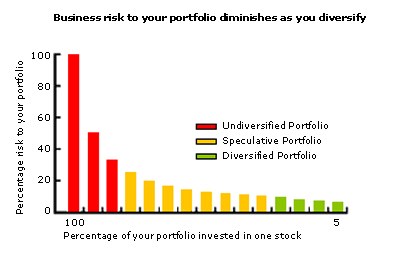| What Is An Appropriate Amount of Diversification? |
| We've seen that adding assets to your account reduces your reliance on just one stock or bond to drive performance. We've also seen that when assets have a low correlation to each other, they can act together to enhance your account's value over time. Correlation is a measure of how closely assets move in relation to each other. |

|
| So, what's the right amount of diversification? According to some investment experts, an appropriately diversified portfolio—one which gives you adequate risk reduction while still holding out a substantial reward—would contain at least 30 securities. Others argue that a more focused portfolio of about 12 securities is best. |
| At the end of the day you can't really measure diversification by numbers alone. You also need to have assets with different characteristics—for example, companies in different economic sectors—to be truly diversified. |
| Here is an example of a stock portfolio that contains many different assets without being diversified. Let's say you put all your money into Wal-Mart stock. You don't want so much exposure to one company, so you move half your funds into stock in Kohl's. Seeking further diversification, you really begin to branch out—Macy's, JCPenney, Saks, and Dillard's and so on. You could end up owning stock in dozens of department store chains. This will reduce some individual company risk, and since many of these chains are strong in certain regions, it may reduce the risk of economic downturns in certain areas. But your investments will still rely too much on the performance of the department store market overall. |
| A portfolio can contain dozens of assets and not be diversified enough. Conversely, it can be fully diversified with fewer than 30. If you choose investments with varying characteristics (such as different industry sectors, different asset types, etc.) it's possible to create a diversified portfolio without buying everything in sight. |
| A good option is to invest in mutual fund as much of the work of diversification will be done for you. Most mutual funds are highly diversified investment vehicles, and even if you only invest in one fund you will still be more diversified than you could be if you bought individual stocks on your own. |
|
> Home
> Glossary > Support |